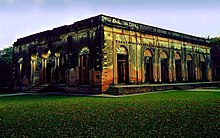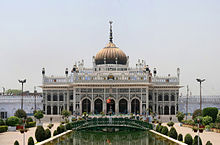Lucknow
![]()
The title of this article is ambiguous. For other meanings, see Lucknow (disambiguation).
d1
Lucknow, also Lakhnau (Hindi: लखनऊ, Urdu: لکھنو; ![]() [ˈlʌkʰnʌuː]), is the capital of the state of Uttar Pradesh in India.
[ˈlʌkʰnʌuː]), is the capital of the state of Uttar Pradesh in India.
It had a population of around 2.8 million at the 2011 census, is an industrial centre (textile industry, metalworking, handicrafts), a transport hub (road, rail, airport) and lies 516 kilometres east of Delhi on the Gomti. Among language purists, Lucknow is considered the place where the purest Urdu and Hindi are spoken.
Lucknow has a rapid population growth. The population of the metropolitan area is expected to exceed 6.3 million by 2050.
History
The city came into existence in 1528 on the orders of Babur (1483-1530), the founder of the Mughal Empire. From the middle of the 18th century, when the Mughal Empire was in decline, the Islamic centre of power slowly shifted from Delhi to Avadh province. In 1775, Asaf-ud-Daula (1775-1797) shifted the capital of his kingdom of Avadh from Faizabad to Lucknow. Avadh became a magnet for poets and artists, where Hindus and Muslims worked together harmoniously. Lucknow was also an important place of Shia culture and Islamic jurisprudence. The jurisprudential school "Farangi Mahal" even attracted students from China and Central Asia. The Sunni school of Lucknow was established in the early 18th century.
That the British removed the last Nawab of Avadh Wajid Ali Shah (1822-1887) from office in 1856 is considered one of the causes of the Indian insurgency of 1857.British forces captured the city in 1856. During the ensuing siege of Lucknow, the city was the scene of fierce fighting between British and rebel Indian forces.
The University of Lucknow was founded in 1921 and the Indian Institute of Management in 1984. The award-winning City Montessori School is the largest school in the world with about 47,000 students.
In 2001, about 20.5% of the population was Muslim.
| Population development (agglomeration) | |||
| Year | Population | Year | Population |
| 1871 | 284.800 | 1951 | 496.900 |
| 1881 | 261.300 | 1961 | 595.400 |
| 1891 | 273.000 | 1971 | 814.000 |
| 1901 | 264.000 | 1981 | 1.007.604 |
| 1911 | 259.800 | 1991 | 1.669.204 |
| 1921 | 240.600 | 2001 | 2.245.509 |
| 1931 | 274.700 | 2011 | 2.902.601 |
| 1941 | 387.177 | ||
Places of interest
Most of the monuments are on or near the south bank of the Gomti, which swells in monsoon and is then crowded with fishing canoes.
To the west of the city, near the "Hardinge Bridge" bordering old Lucknow, are several structures built by the Nawabs of Awadh, including several Imambaras ("Houses of the Imams"), assembly halls for the worship of the Shia Imams. Most notable is the 18th-century Bara Imambara ("Great House of the Imam"), which features one of the largest vaulted halls in the world - 15 meters high, 50 meters long and 16 meters wide. In the attic there is a large three-dimensional labyrinth.
Spanning the main street west of the main entrance gates is the colossal, decaying Rumi Darwaza, a triumphal arch modelled on the High Gate in Istanbul. Steps lead to open spaces with views of the monuments of Hussainabad.
A little further west is the Hussainabad Imambara, also called the Chhota Imambara or "Palace of Lights", because when it is decorated and lit up on special occasions, it resembles a fairytale castle. The Imambara was built in 1837 by Muhammad Ali Shah (1837-1842). The 68-meter high Hussainabad Clock Tower near the Rumi Darwaza was constructed by British architect Richard Roskell Bayne (1827-1901) in 1885.
In the middle of a park southeast of Hardinge Bridge lie the ruins of the British "Residency". It was left exactly as it looked after the months-long siege by rebel Indians finally came to an end on November 17, 1857, with the invasion of British troops under Sir Colin Campbell. Its tower, shattered by a cannonball, became a symbol of British endurance in India.
By the river, in the Rana Pratap Marg, towers the huge dome of the "Shah Najaf Imambara", named after Ali's mausoleum in Iraq and most worth seeing in the glow of lights during the Shiite Muharram festival. The interiors include the silver-plated tomb of Ghazi-ud-din-Haidar (1814-1827), considered decadent and dissolute, who was buried along with three of his wives. This imambara served as a stronghold for the insurgents during the Great Revolt of 1857. On November 16, 1857, the decisive battle took place in the adjacent pleasure garden of Sikandrabag, which enabled the British to liberate the residence. Campbell's troops took an hour and a half to fight their way out; then his Sikhs and the 93rd Highlander Regiment broke through.

The former British "residency" in Lucknow 2010, scarred by the fighting

Bara Imambara

Chhota Imambara
Search within the encyclopedia